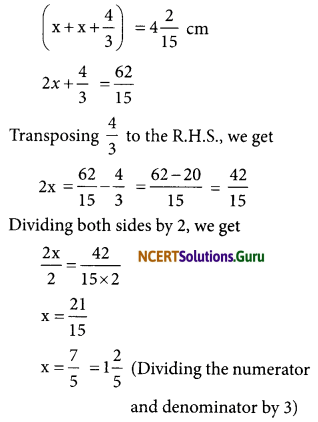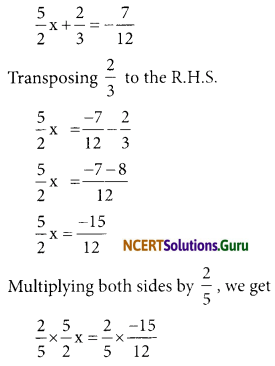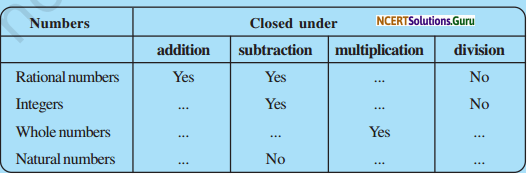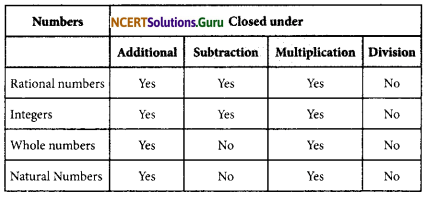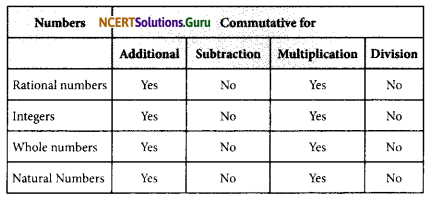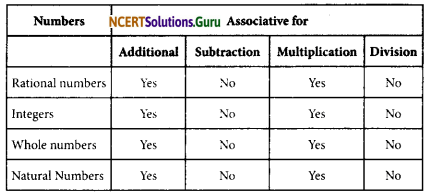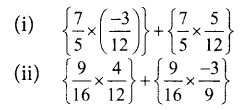NCERT Solutions for Class 8 Maths Chapter 2 Linear Equations in One Variable Ex 2.5
These NCERT Solutions for Class 8 Maths Chapter 2 Linear Equations in One Variable Ex 2.5 Questions and Answers are prepared by our highly skilled subject experts.
NCERT Solutions for Class 8 Maths Chapter 2 Linear Equations in One Variable Exercise 2.5
Solve the following linear equations.
Question 1.
\(\frac{x}{2}-\frac{1}{5}=\frac{x}{3}+\frac{1}{4}\)
Solution:
\(\frac{x}{2}-\frac{1}{5}=\frac{x}{3}+\frac{1}{4}\)
Transposing \(-\frac{1}{5}\) to R.H.S. and \(\frac{\mathrm{x}}{3}\) to L.H.S
\(\frac{x}{2}-\frac{x}{3}=\frac{1}{4}+\frac{1}{5}\)
\(\frac{3 x-2 x}{6}=\frac{5+4}{20}\)
\(\frac{x}{6}=\frac{9}{20}\)
By cross-multiplication, we get
20(x) = 9 × 6
20x = 54
Dividing both sides by 20
\(\frac{20 \mathrm{x}}{20}=\frac{54}{20}\)
x = \(\frac{27}{10}\)
![]()
Question 2.
\(\frac{\mathrm{n}}{2}-\frac{3 n}{4}+\frac{5 \mathrm{n}}{6}=21\)
Solution:
\(\frac{\mathrm{n}}{2}-\frac{3 n}{4}+\frac{5 \mathrm{n}}{6}=21\)
L.C.M of 2, 4 and 6 = 12
Multiplying each term by 12, we get
\(12 \times \frac{\mathrm{n}}{2}-12 \times \frac{3 \mathrm{n}}{4}+12 \times \frac{5 \mathrm{n}}{6}=21 \times 12\)
6n – 9n + 10n = 252
7n = 252
Dividing both sides by 7
\(\frac{7 \mathrm{n}}{7}=\frac{252}{7}\)
n = 36
Question 3.
\(x+7-\frac{8 x}{3}=\frac{17}{6}-\frac{5 x}{2}\)
Solution:
\(x+7-\frac{8 x}{3}=\frac{17}{6}-\frac{5 x}{2}\)
Transposing 7 to R.H.S. and \(\frac{-5 x}{2}\) to L.H.S
\(x-\frac{8 x}{3}+\frac{5 x}{2}=\frac{17}{6}-7\)
L.C.M of 3, 2 and 6 = 6
Multiplying each term by 6, we get
\(6 \times x-6 \times \frac{8 x}{3}+6 \times \frac{5 x}{2}=6 \times \frac{17}{6}-6 \times 7\)
6x – 16x + 15x = 17 – 42
5x = -25
Dividing both sides by 5
\(\frac{5 x}{5}=-\frac{25}{5}\)
x = -5
![]()
Question 4.
\(\frac{x-5}{3}=\frac{x-3}{5}\)
Solution:
\(\frac{x-5}{3}=\frac{x-3}{5}\)
By cross-multiplication we get
5(x – 5) = 3(x – 3)
5x – 25 = 3x – 9
Transposing -25 to R.H.S and 3x to L.H.S.
5x – 3x = 25 – 9
2x = 16
Dividing both sides by 2
\(\frac{2 \mathrm{x}}{2}\) = \(\frac{16}{2}\)
x = 8
Question 5.
\(\frac{3 \mathrm{t}-2}{4}-\frac{2 \mathrm{t}+3}{3}=\frac{2}{3}-\mathrm{t}\)
Solution:
\(\frac{3 \mathrm{t}-2}{4}-\frac{2 \mathrm{t}+3}{3}=\frac{2}{3}-\mathrm{t}\)
Transposing -t to L.H.S., we get
\(\frac{3 \mathrm{t}-2}{4}-\frac{2 \mathrm{t}+3}{3}+\mathrm{t}=\frac{2}{3}\)
L.C.M of 4 and 3 is 12
Multiplying each term by 12
\(12 \frac{(3 \mathrm{t}-2)}{4}-12 \frac{(2 \mathrm{t}+3)}{3}+12 \mathrm{t}=12 \times \frac{2}{3}\)
3(3t – 2) – 4(2t + 3) + 12t = 8
9t – 6 – 8t – 12 + 12t = 8
13t – 18 = 8
Transposing -18 to R.H.S., we get
13t = 8 + 18
13t = 26
Dividing both sides by 13
\(\frac{13 t}{13}=\frac{26}{13}\)
t = 2
![]()
Question 6.
\(m-\frac{m-1}{2}=1-\frac{m-2}{3}\)
Solution:
\(m-\frac{m-1}{2}=1-\frac{m-2}{3}\)
Transposing \(\left(\frac{m-2}{3}\right)\) to L.H.S. we get
\(\mathrm{m}-\frac{\mathrm{m}-1}{2}+\frac{\mathrm{m}-2}{3}=1\)
L.C.M of 2 and 3 is 6
Multiplying each term by 6, we get
6m – \(\frac{6(m-1)}{2}+\frac{6(m-2)}{3}\) = 1 × 6
6m – 3(m – 1) + 2(m – 2) = 6
6m – 3m + 3 + 2m – 4 = 6
5m – 1 = 6
Transposing -1 to the R.H.S., we get
5m = 6 + 1
5m = 7
Dividing both sides by 5, we get
\(\frac{5 m}{5}=\frac{7}{5}\)
m = \(\frac{7}{5}\)
Simplify and solve the following linear equations.
Question 7.
3(t – 3) = 5 (2t + 1)
Solution:
3(t – 3) = 5 (2t + 1)
Opening the brackets, we get
3t – 9 = 10t + 5
Transposing -9 to R.H.S. and 10t to L.H.S.
3t – 10t = 5 + 9
-7t = 14
Dividing both sides by -7, we get
\(\frac{-7 t}{-7}=\frac{14}{-7}\)
t = -2
![]()
Question 8.
15(y – 4) – 2(y – 9) + 5 (y + 6) = 0
Solution:
15(y – 4) – 2(y – 9) + 5(y + 6) = 0
Opening the brackets, we get
15y – 60 – 2y + 18 + 5y + 30 = 0
15y – 2y + 5y – 60 + 18 + 30 = 0
18y – 12 = 0
Transposing -12 to R.H.S.
18y = 12
Dividing both sides by 18, we get.
\(\frac{18 y}{18}=\frac{12}{18}\)
y = \(\frac{2}{3}\)
Question 9.
3(5z – 7) – 2(9z – 11) = 4(8z – 13) – 17
Solution:
3(5z – 7) – 2(9z – 11) = 4(8z – 13) – 17
Opening the brackets, we get
15z – 21 – 18z + 22 = 32z – 52 – 17
15z – 18z + 22 – 21 = 32z – 69
-3z + 1 = 32z – 69
Transposing 1 to R.H.S. and 32z to L.H.S.
-3z – 32z = – 69 – 1
-35z = -70
Dividing both sides by -35, we get
\(\frac{-35 z}{-35}=\frac{-70}{-35}\)
z = 2
![]()
Question 10.
0.25(4f – 3) = 0.05(10f – 9)
Solution:
0.25(4f – 3) = 0.05(10f – 9)
Opening the brackets, we get
0.25(4f) – 0.25 × 3 = 0.05 × 10f – 0.05 × 9
f – 0.75 = 0.5f – 0.45
f – 0.5f = 0.75 – 0.45
0.5f = 0.3
Dividing both sides by 0.5, we get
\(\frac{0.5 \mathrm{f}}{0.5}=\frac{0.3}{0.5}\)
f = \(\frac{3}{5}\) = 0.6
f = 0.6
NCERT Solutions for Class 8 Maths Chapter 2 Linear Equations in One Variable Ex 2.5 Read More »



